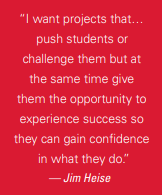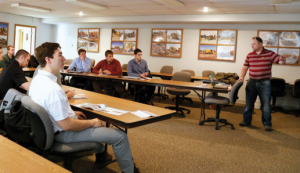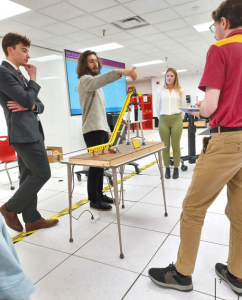The relationship between Iowa industry and CIRAS has been pivotal to the growth of an Iowa State University program that helps senior engineering students apply what they’ve learned in the classroom to a real-world setting.
“Because CIRAS works with manufacturers across the state, they are uniquely positioned to see opportunities within companies for student projects,” said Jim Heise, capstone coordinator for the Department of Mechanical Engineering. “That’s a big reason for our growth and success.”

The current incarnation of the mechanical engineering capstone program was started in 2008. The first year the program had 16 teams and 1 industry sponsor.
For the 2021–2022 academic year, 60 teams worked on 26 industry-sponsored projects. Projects included designing greenhouses for soybean research, creating 3D printing systems to produce houses, designing a drive system for a two-person bicycle, and more.
Jake Behrens, CIRAS project manager, said that capstone projects are popular for businesses throughout Iowa. “Whether the company is looking for an innovative solution to a problem or looking to build their pipeline of talent, there are capstone programs that work for them.”
Gomaco Trolley Company, a manufacturer of vintage trolley cars in Ida Grove, recently engaged capstone students in a project to make variations on the heritage designs to suit specific project needs.
“The students brought a unique perspective to a difficult problem, which carries the potential for developing a valuable solution,” said Lex Jacobson, trolley company manager. “We also feel our participation increased our exposure with faculty and students, which is a potential benefit to recruiting.”
Dan Parrish, an engineering major with Pella Corporation, has also worked with engineering students on capstone projects. “We’ve definitely benefited from the innovation and outside perspective they bring,” he said.
Students recently completed their work on a large forage cart with a 40-ton dumping capacity for Art’s Way Manufacturing. The scale of the product enabled Darren McGregor, director of engineering, to have groups of students working on different aspects of the project. McGregor was impressed with the group’s expertise and professionalism.

“We’ve sponsored a number of capstone projects, and some bear more fruit than others, but it’s always high-quality work,” he said.
Completion of a capstone project is a graduation requirement for all engineering students.

In selecting capstone projects, Heise considers three criteria: his students’ skill sets, whether the project can be well defined, and whether it can be completed in one semester.
“What I’m looking for are those back-burner projects… projects that a company would like to do but doesn’t have resources at the time,” Heise said. “I want projects that will teach students to rely on each other, collaborate, delegate, and support one another. I look for projects that make students think about the people they’re impacting and the consequences of not following through on what’s expected of them. Projects should push students or challenge them but at the same time give them the opportunity to experience success so they can gain confidence in what they do.”
For more information, contact Mayra Ramirez at ramirezm@iastate.edu or 515-520-3101.